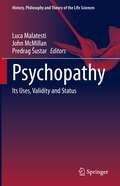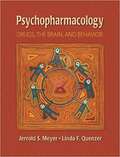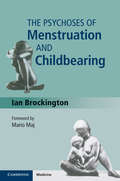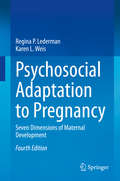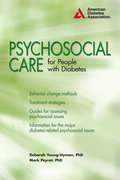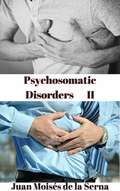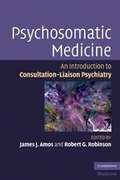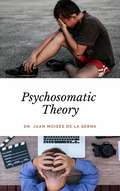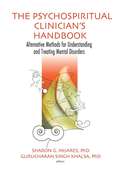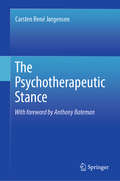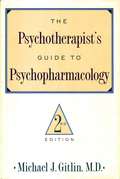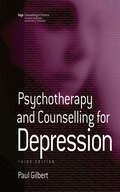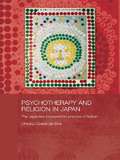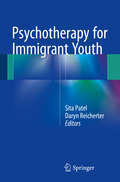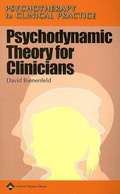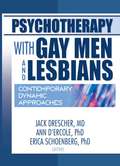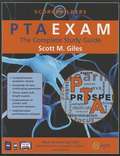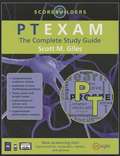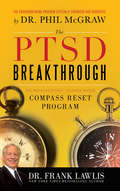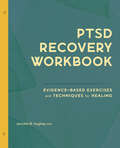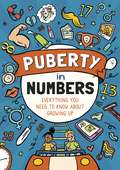- Table View
- List View
Psychopathy: Its Uses, Validity and Status (History, Philosophy and Theory of the Life Sciences #27)
by John McMillan Luca Malatesti Predrag ŠustarThis book explains the ethical and conceptual tensions in the use of psychopathy in different countries, including America, Canada, the UK, Croatia, Australia, and New Zealand. It offers an extensive critical analysis of how psychopathy functions within institutional and social contexts. Inside, readers will find innovative interdisciplinary analysis, written by leading international experts. The chapters explore how different countries have used this diagnosis. A central concern is whether psychopathy is a mental disorder, and this has a bearing upon whether it should be used. The book’s case studies will help readers understand the problems associated with psychopathy. Academics and students working in the philosophy of psychiatry, bioethics, and moral psychology will find it a valuable resource. In addition, it will also appeal to mental health professionals working in forensic settings, psychologists with an interest in the ethical implications of the use of psychopathy as a construct and particularly those with a research interest in it.
Psychopharmacology: Drugs, the Brain, and Behaviors (2nd Edition)
by Richard A. Harvey Michelle A. Clark Richard Finkel Jose A. Rey Karen WhalenRecent advances in molecular pharmacology and brain imaging have revolutionized our understanding of how psychoactive drugs work. Now, from the authors of Principles of Neuropsychopharmacology, comes a new undergraduate textbook integrating these developments. The first section of the book provides extensive foundation materials, including the basic principles of pharmacology, neurophysiology and neuroanatomy, synaptic transmission, and methods in psychopharmacology. The second section describes key features of major neurotransmitter systems, including the catecholamines, serotonin, acetylcholine, glutamate and GABA. The third and fourth sections discuss theories and mechanisms of drug addiction and psychopathology. All major substances of abuse as well as drugs used to treat mental illness are covered. Psychopharmacology: Drugs, the Brain and Behavior is unique in its breadth of coverage, ranging from historical accounts of drug use to clinical and preclinical behavioral studies to the latest research on drug effects in transgenic mouse models. Student engagement with the material is fostered by opening each chapter with a relevant vignette and by providing breakout boxes presenting novel or cutting-edge topics for special discussion. The book is extensively illustrated with full-color photographs and line art depicting important concepts and experimental data. Psychopharmacology: Drugs, the Brain and Behavior is appropriate for undergraduate psychopharmacology or drugs and behavior courses that emphasize relationships between the behavioral effects of psychoactive drugs and their mechanisms of action.
The Psychoses of Menstruation and Childbearing
by Ian BrockingtonChildbearing, from the standpoint of psychological medicine, is the most complex event in human experience. Of the dozens of disorders that affect the generative process, or are unleashed as complications, many fall under the heading of 'psychoses' - profound disturbances of thought, perception, cognition and behaviour. These psychoses disrupt personal and family life at a critical time. Reviewing the wide range of psychoses that complicate the reproductive process, Ian Brockington proposes radical changes to the concepts of postpartum and menstrual psychoses, with suggestions for fresh research initiatives. Armed with this comprehensive knowledge and wielding a raft of interventions, many women can be restored to health and their vital roles in the family and community. When the risk factors are known, multidisciplinary preventive strategies can transform the lives of vulnerable women. This is essential reading for psychiatrists, obstetricians and gynaecologists, midwives, general practitioners, neuroscientists and related professions worldwide.
Psychosocial Adaptation to Pregnancy: Seven Dimensions of Maternal Development
by Regina P. Lederman Karen L. WeisThe fourth edition of this book updates and elaborates on the seven dimensions of maternal emotional health that have significant impact on delivery, postpartum adaptation, infant health, and early childhood development. Supported by the authors’ original research and interviews, the book provides readers with an analysis of the role of these core functions throughout pregnancy, as well as practical materials for use with pregnant clients in the form of assessment instruments and evidence-based interventions for promoting positive development. The book provides a theoretical framework with rationales for the seven psychosocial dimensions, therapeutic and counseling intervention strategies to improve adaptive development in each of the seven psychosocial dimensions, findings specific to women in diverse cultural groups, a chapter devoted to women in the military and military spouses, and discussion of salient issues of pregnancy, including physical changes, body image, intimacy, trust, and ambivalence.The book focuses on the seven dimensions of maternal prenatal emotional health:Acceptance of the pregnancy.Motivation and preparation for motherhood.Relationship with husband/partner.Relationship with her own mother. Preparation for labor.Sense of control in laborSelf-Esteem and Well-Being in labor. Psychosocial Adaptation to Pregnancy is a significant addition to the psychosocial assessment literature, a needed resource for clinical and health psychologists, clinical social workers, marriage and family therapists, professional counselors, midwives, and obstetrical nurses. It is also adaptable to undergraduate and graduate courses in maternal reproductive health and obstetrical nursing.
Psychosocial Care for People with Diabetes
by Mark Peyrot Deborah Young-HymanPsychosocial Care for People with Diabetes describes the major psychosocial issues which impact living with and self-management of diabetes and its related diseases, and provides treatment recommendations based on proven interventions and expert opinion. The book is comprehensive and provides the practitioner with guidelines to access and prescribe treatment for psychosocial problems commonly associated with living with diabetes.
Psychosocial Care of Children in Hospitals: A Clinical Practice Manual from the ACCH Child Life Research Project
by John Wolfer Joy Goldberger Richard H. Thompson Lisa Redburn Lesley Laidley Laura GaynardThis manual describes the organization and development of a research-based child life program that was implemented at Phoenix Children's Hospital from 1985 to 1987, and it details the principles, guidelines, protocols, and practices that shaped the program. Although it has been written primarily for child life administrators, clinicians, educators, researchers, and students, it is also of value to health professionals from many other disciplines. The integration of theory and practice, the clinical detail, and the inclusion of specific examples are designed to help a//readers understand and learn from the ACCH Child Life Research Project's successful approach to psychosocial care of hospitalized children and their families.
PSYCHOSOMATIC DISORDERS II
by Juan Moises de la Serna Cristina MaroiuPsychosomatic pathologies lead many patients to wander from a medical office to another without finding a clear diagnosis of their condition, and above all without receiving the appropriate treatment, or discovering how to identify it and what is the best treatment for each case. Psychosomatic disorders have a complex clinical picture, are difficult to diagnose and require a global intervention in order to be treated. This text describes these types of disorders, how they affect one's health, what their causes are, and what types of therapeutic interventions can cure them.
Psychosomatic Medicine: An Introduction to Consultation-Liaison Psychiatry
by James J. Amos Robert G. RobinsonPsychosomatic medicine or consultation-liaison psychiatry is the branch of psychiatry that focuses on the mental health issues which accompany, or develop as a result of, other medical disorders. This subdiscipline forms an important part of training in psychiatry. This book provides an ideal first exposure to the inseparable nature of physical and psychological health and illness, and a comprehensive introduction to the broad range of disorders seen on the psychiatric consult service. Organized into a series of bitesized chapters, each focusing on a typical consult question, this handbook provides a practical and portable reference which should set both strategy and tactics for the next generation of consulting psychiatrists. Essential reading for medical students, psychiatry residents and psychosomatic fellows, this manual will provide immediate, in-the-field guidance on the evaluation and management of common consultation requests. <P><P><i>Advisory: This book offers only partial accessibility. We have kept it in the collection because it is useful for some of our members. Benetech is actively working on projects to improve accessibility issues such as these in the future.</i>
Psychosomatic Theory
by Juan Moises de la SernaPreface Emotions are a source of life and pleasure, but when they acquire certain negative nuances and become chronic, they can contribute to the appearance of psychosomatic disorders. These disorders are more frequent than one might imagine, especially because there is a great lack of understanding in the individual's overall health, how to preserve it and how to take care of it. This text is presented as a first approach to the subject of psychosomatic disorders from a theoretical perspective. Objective: The aim of this book is to serve as a first approach to psychosomatic medicine, focusing on the explanatory theories of its origin and its "function". A text to bring the reader closer to one of the most important challenges that medicine has taken on halfway through psychology, the psychosomatic disorders. Target audience: - Health practitioners who want to delve deeper into the effects of emotions on health - People suffering from psychosomatic disorders and to their families, so that they can learn in depth about this new perspective of the disorder - Anyone interested in learning how emotions can affect health and how to approach treatment from a holistic point of view Topic - Psychosomatic Approach and Psychosomatic Disorders This section covers the origin of the explanatory theories on the psychosomatic approach, and what type of disorders are included from this perspective. - The Psychosomatic Personality In this section is analyzed the origin of personality, its formation over time and the health problems of an "inadequate" personality. - Approach to Psychoneuroendocrinoimmunology (PNEI) Considered as the last great contribution of health science, this approach poses a model for overcoming the limitations of medicine and psychology, which only provide a limited view of psychosomatic disorders.
The Psychospiritual Clinician's Handbook: Alternative Methods for Understanding and Treating Mental Disorders
by Sharon G Mijares Gurucharan Singh KhalsaLearn to treat a variety of diagnostic disorders through various psychospiritual treatment models!Increasing numbers of people are moving beyond psychological therapy to seek alternative spiritual perspectives to medical and mental health care such as yoga and meditation. The Psychospiritual Clinician’s Handbook: Alternative Methods for Understanding and Treating Mental Disorders provides the latest theoretical perspectives and practical applications by recognized experts in positive and integrative psychotherapy. Leading clinicians examine and re-examine their therapeutic worldviews and attitudes to focus on the right problems to solve—for the whole person.This essential Handbook is a window on the quiet revolution now sweeping the field of psychology, that of locating the whole human being in the center of the therapeutic process. The Psychospiritual Clinician’s Handbook: Alternative Methods for Understanding and Treating Mental Disorders helps you effectively treat the whole person by providing a practical introduction to some of the worldviews and most effective practices like yoga, meditation, and humanological therapy used by psychospiritually oriented therapists. Helpful illustrations of body positions used in yoga and meditation plus photographs, tables, figures, and detailed case studies illustrate the process.The Psychospiritual Clinician’s Handbook: Alternative Methods for Understanding and Treating Mental Disorders will show you: the importance of a therapist’s worldview for effective therapeutic outcome new perspectives on alternative treatments for depression, anxiety, eating disorders, OCD, PTSD, ADHD, Alzheimer’s disease, and sexual dysfunction how yoga and mindfulness meditation can be used in psychotherapy the use and integration of meditation therapies in emergency situations the therapeutic integration of other alternative treatments, such as Kundalini yoga each contributor’s case studies as illustration of effective treatmentThe Psychospiritual Clinician’s Handbook: Alternative Methods for Understanding and Treating Mental Disorders is an invaluable resource for those interested in treating patients with a therapeutic process that is effective, adaptable, and wholly transformational.
The Psychotherapeutic Stance
by Carsten René JørgensenThis book provides a thorough critique of the dominating medical understanding of psychotherapy and argues for a dynamic relational understanding of psychotherapy, deeply founded in the most important results from empirical psychotherapy research. In the first part, the book critically examines the traditional focus on technical factors in psychotherapy based on available empirical research on the subject. It asks questions about whether specific techniques cure specific diagnoses or therapists and therapeutic relationships that cure persons. Part II of the book argues that the currently dominating medical understanding of psychotherapy must be challenged by a better understanding of psychopathology and psychotherapy that contextualizes the relationship between therapist and the patient. Overall, this book provides a new approach to some of the most important questions in psychotherapy and discusses what it means to think and work psychotherapeutically. The book is highly relevant for professionals in clinical/psychotherapy training and for advanced courses in psychotherapy, including courses on mentalization-based therapy, psychoanalytic psychotherapy and eclectic psychotherapy.
The Psychotherapist’s Guide to Psychopharmacology
by Michael J. GitlinGitlin (psychiatry, UCLA) provides a guide to medicines used for treating mental and emotional disorders, designed to familiarize mental health professionals who do not prescribe medicine with the latest medical treatment options. He describes the type of treatment used for numerous disorders, explaining in detail how each medication works and its effects.
Psychotherapist's Guide To Psychopharmacology
by Michael J. GitlinThe last twenty-five years have witnessed an explosion of knowledge about the influence of brain biochemistry on mood and behavior and about pharmacological approaches to treating mental and emotional disorders. A substantial portion of patients seen in clinical practice are taking some medication or might usefully be advised to do so. But many clinical psychologists, social workers, and counselors need additional information in order to better treat patients already on medication, know when and to whom to refer new patients for psychiatric consultation, and work collaboratively with psychiatrists when appropriate. Michael J. Gitlin's indispensable first edition of The Psychotherapists Guide to Psychopharmacology has now been updated and revised -- this new second edition now reflects major changes that have influenced the clinical arena in the last five years such as the recent release of DSM-IV and the domination of the psychopharmacological field by the selective serotonin reuptake inhibitors, such as fluoxetine (Prozac). The Psychotherapists Guide to Psychopharmacology, Second Edition also now includes coverage of attention deficit/hyperactivity disorder and contains updated sections on the new antipsychotics for schizophrenia and the increased use of anticonvulsant mood stabilizers for bipolar disorder. The book also includes other significant changes that have influenced the field over the last few years, such as brain imaging studies, research in obsessive compulsive disorder and social phobia, and such prominent topics in women's health as pregnancy, PMS, postpartum disorders, and breast feeding. This revision of an already established guide will again be an essential reference for all nonmedical professionals involved in treating mental and emotional disorders.
Psychotherapy and Counselling for Depression (Therapy in Practice)
by Paul Raymond Gilbert`Excellent! Excellent! Excellent! I would thoroughly recommend this book to any other counsellor of psychotherapist. It is described on the back cover as 'outstanding', 'valuable' and an 'essential resource' and I would fully endorse all of these descriptions. I have been qualified for 10 years and have had extensive client experience, but feel I have gained so much from Gilbert's wisdom on this topic. It is excellent value for money and again I would recommend it to any practitioner' - The Independent Practitioner 'This book takes the reader gently but thoroughly through the biopsychosocial processes that underpin depression. Excellent worksheets and information sheets are provided as appendices. [It] is a valuable resource for those who already work with depression and essential reading for those considering working in this field' - Therapy Today `Paul Gilbert provides the reader with a refreshingly wide-ranging, integrative and up-to-date understanding of the nature, assessment and treatment of depression. All psychological therapists will benefit from reading his important book' - Healthcare Counselling and Psychotherapy Journal `Paul Gilbert writes in a scholarly, yet accessible, style on the bio-psychosocial perspectives of depression. I agree with him that knowledge of such areas is crucial to being able to work effectively with people experiencing depression' - Nursing Standard, 5 star review `Psychotherapy and Counselling for Depression, Third Edition by the distinguished psychologist, Paul Gilbert, is an outstanding contribution to the field. I read this book with great enthusiasm and interest - and, I must acknowledge - admiration. All clinicians will benefit from reading this valuable book' - Robert L. Leahy, President, International Association for Cognitive Psychotherapy Paul Gilbert's Psychotherapy and Counselling for Depression, Third Edition is a popular and practical guide to working with people suffering from depression. The book is based on a wealth of research into evolutionary, cognitive, behavioural and emotion-focused approaches to depression. It outlines how to work with general negativity, sense of failure and abandonment, and feelings of powerlessness, anger, shame and guilt The book examines the essential stages of the therapeutic process from conceptualization and formulation through to a wide variety of interventions for different types of difficulty. It has been greatly revised, expanded and updated for the Third Edition and: o explores in depth the biopsychosocial processes underpinning depression o shows how a compassionate mind approach can be incorporated into different types of therapy o includes a new chapter focusing on the role of the therapeutic relationship, including therapeutic dialogues o features detailed guidance with case examples on how to work with a wide variety of depressions. Psychotherapy and Counselling for Depression, Third Edition is an essential resource and comprehensive guide for practitioners and anyone involved with treating depression. Paul Gilbert is Professor of Psychology in the Mental Health Research Unit at Kingsway Hospital, Derby.
Psychotherapy and Religion in Japan: The Japanese Introspection Practice of Naikan (Japan Anthropology Workshop Series)
by Chikako Ozawa-de SilvaNaikan is a Japanese psychotherapeutic method which combines meditation-like body engagement with the recovery of memory and the reconstruction of one's autobiography in order to bring about healing and a changed notion of the self. Based on original anthropological fieldwork, this fascinating book provides a detailed ethnography of Naikan in practice. In addition, it discusses key issues such as the role of memory, autobiography and narrative in health care, and the interesting borderland between religion and therapy, where Naikan occupies an ambiguous position. Multidisciplinary in its approach, it will attract a wide readership, including students of social and cultural anthropology, medical sociology, religious studies, Japanese studies and psychotherapy.
Psychotherapy for Immigrant Youth
by Daryn Reicherter Sita PatelThis book provides an in-depth, practical, and cutting-edge summary of psychotherapy for immigrant children and adolescents. This text integrates practical therapeutic methods with current empirical knowledge on the unique life stressors and mental health concerns of immigrant youth, proving essential for all who seek to address the psychological needs of this vulnerable and under-served population. Specific chapters are devoted to trauma, refugees and forced displacement, cognitive-behavioral therapy, psychopharmacological issues, school-based treatment, family. Each chapter includes specific cultural concerns and treatment techniques for immigrant groups from various regions of the world. In-depth case examples illustrate case formulation, how and when to use specific techniques, challenges faced in the treatment of immigrant youth, and responses to common obstacles. With detailed theory and practice guidelines, Psychotherapy for Immigrant Youth is a vital resource for psychologists, psychiatrists, social workers, and other practitioners.
Psychotherapy in Clinical Practice: Psychodynamic Theory for Clinicians
by David BienenfeldPsychodynamic Theory for Clinicians, explains the major psychodynamic theories and shows how they provide a framework for clinical reasoning throughout the process of psychotherapy. Several clinical cases are presented at the beginning of the book and discussed throughout the text so readers can follow these patients in the context of each theoretical approach.
Psychotherapy with Gay Men and Lesbians: Contemporary Dynamic Approaches
by Jack Drescher Ann D'Ercole Erica SchoenbergExamine gay and lesbian psychoanalysis from a variety of perspectives! Psychotherapy with Gay Men and Lesbians: Contemporary Dynamic Approaches presents case histories of psychotherapy sessions with gay and lesbian patients, focusing on today's psychoanalytical approaches. Dedicated to enhancing the emotional, psychological, and psychiatric treatment of gay men, lesbians, and bisexuals, the book features prominent analysts with a wide range of clinical and theoretical approaches. The foremost experts in the therapeutic field address issues affecting gay and lesbian patients from psychoanalytic perspectives that respect the patients' sexual identities. Psychotherapy with Gay Men and Lesbians reflects the significant clinical and theoretical changes therapists face in dealing with issues of gender and sexuality. New ways of thinking coexist with traditional theory as paradigm shifts in psychotherapy and psychoanalysis affect the treatment of gay, lesbian, and bisexual patients. This book provides a forum to address those changes through clinical papers and discussions. Psychotherapy with Gay Men and Lesbians includes discussion of case reports that deal with: gay therapists treating gay patients countertransferential enactments of sex and gender in treatment rethinking the meanings of homosexuality psychotherapeutic treatment of gay male patients with AIDS and much more! Psychotherapy with Gay Men and Lesbians is an essential forum for the exchange of clinical information on gay and lesbian psychotherapy. The book is a valuable resource for psychiatrists, psychologists, social work therapists, psychoanalysts, and anyone interested in today's psychoanalytic approaches to homosexuality.
PTAEXAM: The Complete Study Guide
by Scott M. Giles"Perhaps the most valuable piece of Information a candidate can utilize when preparing for the National Physical Therapist Assistant Examination is the National Physical Therapist Assistant Examination Blueprint. The blueprint provides a detailed analysis of each of the content areas of the National Physical Therapist Assistant Examination. A thorough understanding of the content outline and system specific weighting will streamline a candidate's preparation. Less time will be spent covering topics that are not clinically relevant to the actual examination and as a result, more time will be available for reviewing and relearning. Perhaps the most valuable piece of Information a candidate can utilize when preparing for the National Physical Therapist Assistant Examination is the National Physical Therapist Assistant Examination Blueprint. The blueprint provides a detailed analysis of each of the content areas of the National Physical Therapist Assistant Examination. A thorough understanding of the content outline and system specific weighting will streamline a candidate's preparation. Less time will be spent covering topics that are not clinically relevant to the actual examination and as a result, more time will be available for reviewing and relearning.
PTAEXAM: The Complete Study Guide (6th Edition)
by Scott M. GilesPtaexam: The Complete Study Guide is the most comprehensive resource available for the National Physical Therapy Examination (NPTE-PTA) and sets a new standard for review book excellence. This edition raises the bar further by introducing numerous innovative features that are described in detail in "What's New in This Edition?"
PTExam: The Complete Study Guide
by Scott M. GilesThe changes to the new edition includes a significant expansion of the academic review section along with the integration of full color. Chapter essentials and proficiency exercises throughout the review book assist students to develop mastery of essential National Physical Therapy Examination content. Our clinically-oriented questions with expansive explanation of answers prepare candidates for the rigor of the actual exam and offer an ideal method to determine current strengths and weaknesses.
PTA Examination Review & Study Guide
by Susan O'Sullivan; Raymond Siegelman; Karen RyanTherapyEd PTA Examination Review & Study Guide prepares students for all aspects of the NPTAE exam with a comprehensive review of physical therapy content, study and test-taking strategies, current licensure information and three complete simulated exams online
The PTSD Breakthrough: The Revolutionary, Science-Based Compass RESET Program
by Frank Lawlis<p>We are facing a hidden and growing epidemic. More than a million veterans and everyday citizens have been affected with Post Traumatic Stress Disorder as a result of a traumatic event or personal experience. And until now, there has been little understanding of how the disorder truly takes hold and how to reverse its destruction. Finally, a breakthrough approach has been discovered. <p>Previously PTSD was treated as a psychiatric disorder only, but new scientific research shows that biological factors play just as an important of a role, specifically brain and soft-tissue damage underlying the root causes of the disorder. The PTSD Breakthrough is the first book to describe the true causes of PTSD and provide an effective program for overcoming the disorder. There is hope. <p>Through the research conducted by Dr. Lawlis and his colleagues, for the first time those who suffer from PTSD, as well as their families and loved ones, will discover that this disorder can be treated and healed, and that our veterans and all who suffer from PTSD can regain true peace in their lives. </p>
PTSD Recovery Workbook: Evidence-based Exercises and Techniques for Healing
by Jennifer B. Hughes PhDUnderstand and overcome PTSD with proven healing exercises Recovering from PTSD is a gradual process that requires deep introspection and expert guidance—which means getting started can feel overwhelming. But this trauma workbook is here to ease your way, offering a safe space for you to learn how trauma and PTSD affect your brain and body, reflect on your experiences, and explore strategies to support your healing journey. What sets this PTSD workbook apart from other trauma books: A hands-on workbook format—Discover clear and organized advice paired with thought experiments, checklists, and writing prompts that help you identify your feelings and record your progress. Support for any type of trauma—Find the strength to navigate all kinds of trauma, whether it's from military combat, an abusive relationship, an accident, or anything else that's been difficult to overcome, no matter how big or small. A mix of therapy techniques—Try out strategies built on a variety of evidence-based recovery methods including cognitive behavioral therapy, somatic therapy, and exposure therapy. Face your past and cope with trauma—the PTSD Recovery Workbook is your first step.
Puberty in Numbers: Everything you need to know about growing up
by Liz FlavellEmbarrassment can do one! This entertaining guide to puberty gives you all the information you need to hold your head up and enter puberty armed with solid facts. Puberty need not be scary and unknown. With a colourful and cool design, and bite-size text with attention-grabbing numbers and visuals, find out the facts and stats behind growing up, from how much extra hair you'll grow, to how puberty might make you feel, and what happens when puberty hormones kick in. Written in a straightforward, down-to-earth way, this book will give you all the information you need to understand and be reassured by any changes puberty throws at you. The book emphasises body positivity and reassures you that everything you are experiencing is totally normal! It also includes a section on gender identity and sexuality. For children aged 9+, this book is an excellent resource for the PSHE curriculum, and the 2020 RSE curriculum, including consent. While it is perfect for parents, teachers and carers to use for discussion topics, it is also accessible for children to read for themselves.
